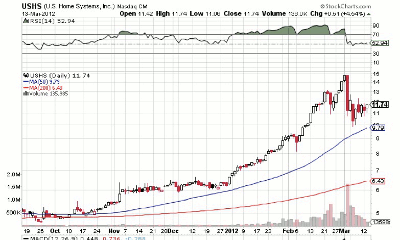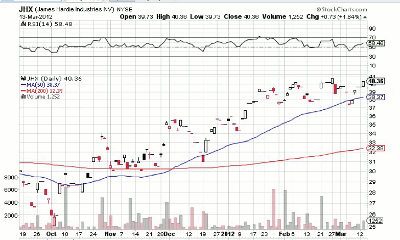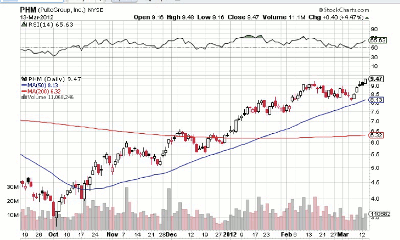Builders have been showing technical strength, and companies from related industries are also rebounding from prior lows. Fundamentals in many of these names are improving as well, writes MoneyShow.com contributor Kate Stalter.
As the housing sector has been in rally mode lately, it’s not only builders that have shown gains, but also stocks from related industries.
One low-priced stock that showed up on my scans is US Home Systems (USHS), which makes kitchen, bath, garage, and closet products, sold through Home Depot (HD) and other retail channels.
Not surprisingly, this company suffered some rough years with the housing bust and overall economic decline. It posted earnings declines in 2007 and 2008, and then a yearly loss in 2009.
The profitability situation has turned around since then, with income of 30 cents per share in 2010. The company reports full-year 2011 results Thursday, and annual earnings are expected to more than double, to 64 cents per share.
The chart is showing potential, though there’s been some volatility lately. It’s been getting solid ten-week support, which is encouraging. However, as USHS has rallied higher, the stock has not paused to flush out some excesses. In other words, the last time it undercut the low of a prior base was in the 2008-2009 bear market.
Clearly, that’s not likely to happen in the current consolidation. But in the weeks or months ahead, such selling action may be necessary to clear the way for further gains.
The stock tumbled nearly 24% on March 2 in monster volume, but rested just below its 20-day line, and well above its 50-day. This was an excellent reminder of the inherent risk in small, low-priced stocks.
USHS has a market cap of only $82 billion, though as volume has increased in recent weeks, the stock now moves 248,000 shares per day, on average. But the stock has scant institutional ownership. That means only one major investor’s selling can send the stock sharply lower.
It’s not atypical to see selling after a stock has made a mad dash to new highs. USHS had been rallying since November. The pace of the rally accelerated in recent weeks, both in terms of price and volume gains.
That kind of sudden run-up often leads to topping in a stock, so it was not unusual to see selling one day after USHS reached its best level since June 2007.
This type of topping action can also signal further declines, because institutional investors have already shown a willingness to sell. However, good news from Thursday’s earnings report could lift investor sentiment about the company.
Another housing-related small stock is James Hardie (JHX), an Ireland-based maker of cement siding and other products used in the construction business. Its products are sold worldwide.
The company has posted an erratic track record of profitability in recent years, vacillating between year-over-year gains and declines. However, it finished 2011 with earnings of $1.63 a share, up 35% over 2010. This year, analysts are eyeing income of $2.14 per share, which would be a 31% gain.
This ADR has a high beta, 1.22, indicating a propensity to volatility greater than the general market. Though it’s a midcap, with a capitalization of nearly $3.5 billion, it’s extremely thinly traded in the US, moving a paltry 900 shares a day.
Risky? Absolutely. However, for aggressive investors, the stock is showing good chart action, as it regained its ten-week average last week.
Its daily chart shows regular price gaps on a day-to-day basis. That’s common not only in thin stocks, but also in some ADRs whose prices reflect currency-exchange differences.
A new buy point may present itself if the stock rallies back above $40.81, its high price from February 27. However, given the volatility and thin trade, the prudent buyer should be prepared to sell quickly if the stock falls below its 50-day line—or even sooner.
|pagebreak|Of course, some of the better known sector gainers are the builders themselves. Pulte Homes (PHM) fell off my radar for years, after it tanked along with the entire sector.
However, it’s been showing good chart action lately, trending higher and then getting ten-week support.
The stock is currently in technical buy range, having moved slightly above its February 15 intraday high of $9.31, before it pulled back to its ten-week line.
A smaller builder, KB Home (KBH), has been exhibiting very similar chart moves. While it has yet to regain its prior intermediate high of $12.91—also from February 15—KB Home has also been climbing higher after a ten-week rebound.
I don’t like putting two similar companies into my portfolio simultaneously, so given the choice between Pulte and KB Home, I would go with Pulte. It’s a fundamentally stronger company, having swung back to profitability last year.
KB Home, meanwhile, is expected to report a loss of 35 cents per share, which would be its sixth year in a row in the red.
At the time of publication, Kate Stalter did not own positions in any of the stocks mentioned in this column.
Related Reading:























